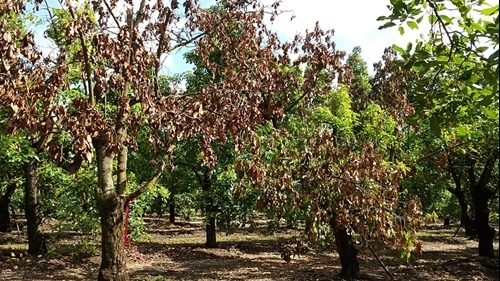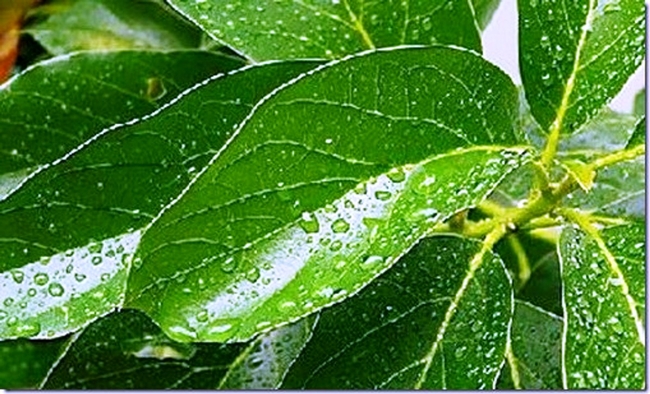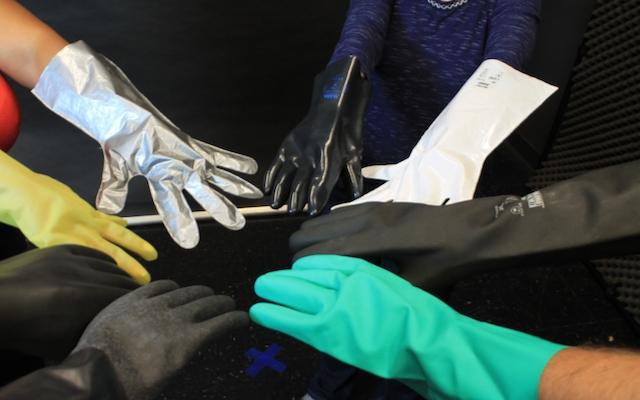- Author: Ben Faber
I just came across a wonderful summary of the different methods that can be used to schedule irrigations based on plant sensors. In th past this is has been labor intensive and not easily adapted to commercial agriculture. This review covers some of those problems and how they have or not been overcome by new technologies. Of course, plant-based techniques are the not the only way to schedule and may only be part of the variety of methods used, such as soil-based ones like tensiometers; or weather-based ones, like ET. A shovel and just looking at trees helps too.
Plant-Based Methods for Irrigation Scheduling
of Woody Crops
ABSTRACT
The increasing world population and expected climate scenarios impel the agricultural sector towards a more efficient use of water. The scientific community is responding to that challenge by developing a variety of methods and technologies to increase crop water productivity. Precision irrigation is intended to achieve that purpose, through the wise choice of the irrigation system, the irrigation strategy, the method to schedule irrigation, and the production target. In this review, the relevance of precision irrigation for a rational use of water in agriculture, and methods related to the use of plant-based measurements for both the assessment of plant water stress and irrigation scheduling, are considered. These include non-automated, conventional methods based on manual records of plant water status and gas exchange, and automated methods where the related variable is recorded continuously and automatically. Thus, the use of methodologies based on the Scholander chamber and portable gas analysers, as well as those of systems for measuring sap flow, stem diameter variation and leaf turgor pressure, are reviewed. Other methods less used but with a potential to improve irrigation are also considered. These include those based on measurements related to the stem and leaf water content, and to changes in electrical potential within the plant. The use of measurements related to canopy temperature, both for direct assessment of water stress and for defining zones with different irrigation requirements, is also addressed. Finally, the importance of choosing the production target wisely, and the need for economic analyses to obtain maximum benefit of the technology related to precision irrigation, are outlined.
https://www.mdpi.com/2311-7524/3/2/35/htm

- Author: Ben Faber
There's a new volume out.
Check it Out!!
Topics in Subtropics, Volume 22, Winter 2020
In this issue:
- Rattlesnakes in California Orchards
- What's the Fuss Over Spotted Lantern Fly?
- Frost Freeze Recovery from February 2020
- Covid Virus Resources
- New Guidelines for Laurel Wilt Disease
You can read through the archives and subsribe at:
http://ceventura.ucanr.edu/news/Topics_in_Subtropics/
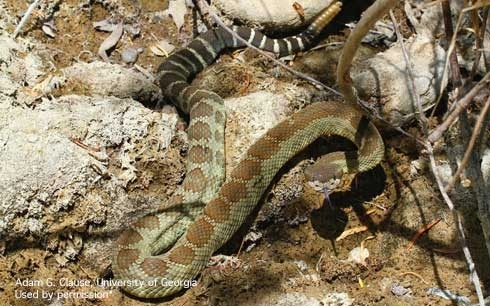
- Author: Ben Faber
Foliar fertilizer application is sometimes promoted as an effective means of supplying nutrients to avocado. On the market are various products being promoted as foliar nutrients for avocado, some proponents even suggest that their products do away with the need for soil applied nutrients. The nature of the avocado leaf severely limits its capacity to absorb foliar sprays.
The structure of plant leaves has evolved primarily to capture sunlight and exchange gases, roots have evolved to absorb nutrients and water and anchor the plant. Any absorption of nutrients by leaves is therefore likely to be more fortuitous than by design. In some crops passive nutrient absorption by leaves is occasionally sufficient to supplement the supply of nutrients taken up by the roots. Most often this involves trace elements, which as their name suggests are required in very small amounts (eg. copper and zinc). However if non-mobile elements or elements with limited mobility in the plant (eg. calcium, phosphorus, zinc, boron and iron) are absorbed when foliar sprayed they are not likely to make it down to the roots where they are also needed. Most nutrients will move freely in the water stream but the movement of many is restricted in the phloem, hence leaf applications don't meet the requirements of deficient trees. Occasionally major elements (such as nitrogen and potassium) are applied to make up for a temporary shortfall or provide a boost at a critical time. Citrus is an example of a crop where some benefits from foliar applied nutrients have been reported.
The ability of the leaf to absorb nutrients from its surface must depend to some degree on the permeability of its epidermis (outer layer) and the presence and density of stomates (pores for the exchange of gases). Scanning Electron Microscope studies of mature leaves and floral structures in avocado show the presence of a waxy layer on both the upper and lower surfaces of mature avocado leaves (Whiley et al, 1988). On the upper surface the wax appears as a continuous layer and there are no stomates. On the lower surface the wax layer is globular and stomates are present. Blanke and Lovatt (1993) describe the avocado leaf as having a dense outer wax cover in the form of rodlets on young leaves and dendritic (branching) crystals on old leaves including the guard cells (guard cells surround stomates). The flower petals and sepals in avocado have stomates on their lower surfaces and no wax layers on either surface, which might explain why floral sprays of boron might work.
Blanke, M.M. and Lovatt, C.J. 1993. Anatomy and transpiration of the avocado inflorescence. Annals of Botany, 71 (6): 543-547.
Whiley, A.W., Chapman, K.R. and Saranah, J.B. 1988. Water loss by floral structures of avocado (Persea americana cv. Fuerte) during flowering. Australian Journal of Agricultural Research, 39 (3): 457-467.
The avocado leaf, water beading up on the waxy cuticle.
An avocado leaf with its cuticle (white, paperlike surface) being exposed by underlying leaf fungi.
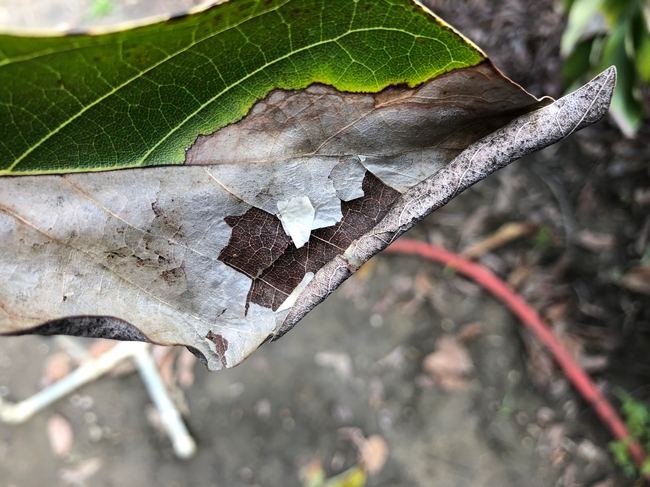
- Author: Ben Faber
PPE in short supply for farm work
during the COVID-19 crisis
While most Californians are staying home to slow the spread of the novel coronavirus, California farmers, farmworkers and other agricultural professionals are out in the fields and packing houses working to produce food.
With increased demand for personal protective equipment, or PPE, to protect against COVID-19, these essential workers are facing shortages. Agricultural commissioners in 28 counties are hearing from farmers who are having trouble getting PPE for their employees and farmers in another 11 counties who are worried about running out of PPE in the next month or twoaccording to a California Department of Pesticide Regulation survey.
Gloves, N95 respirators, coveralls and other gear that workers wear to protect themselves from COVID-19, pesticides, dust and other health hazards are in short supply as priority is given to health care workers during the pandemic.
To reduce the spread of COVID-19, workers may wear homemade face coverings, but for applying pesticides, they must wear respirators specified on the pesticide product label, said Whitney Brim-DeForest, UC Cooperative Extension rice advisor.
Pesticide applicators may use gear that is more protective than required by the product label and regulations.
“Although this could change in the days ahead, half-mask and full-mask respirators are more available than disposable N95 respirators for now,” said Lisa Blecker, coordinator for the UC Pesticide Safety Education Program.
Before the pandemic, 10% of N95 respirators from 3M went to health care, but that number is now 90%, the company said in a letter to distributors. This has led to significant backorders of PPE supplies for distributors.
Carl Atwell, president of Gempler's, an online distributor of worker supplies,, said that before the crisis, normal lead times for PPE was up to 10 days. He estimated disposable respirators will become available in the fall and other PPE supplies in August.
In the meantime, there is alternative PPE that agricultural professionals can use during the shortage.
Atwell suggests looking for lesser known brands of PPE as opposed to the first tier of choice: “It's sort of like searching for Purell hand sanitizer. Purell brand might be out of stock, but can you find a different disinfectant?”
On Gempler's website, the more recognizable Tyvek coverall from Dupont is sold out, however disposable protective clothing is available from other brands. Reusable chemical-resistant clothing is also available as opposed to their disposable counterparts. Supplies in high demand are reusable and disposable nitrile gloves, protective clothing, disposable respirators and certain protective eyewear, such as goggles and face shields.
For workers who will be applying pesticides, Blecker and Brim-DeForest offered some guidelines on how to meet PPE requirements as the shortage continues.
General PPE requirements: “Remember, the label is the law,” said Brim-DeForest. “PPE requirements for agriculture are not being loosened.” The UCCE advisor recommends purchasing only what you need for the season and choosing reusable PPE whenever possible. Growers who have excess supplies of PPE can coordinate with their county agricultural commissioner or UCCE advisor to help other producers in their area.
Respirators: If you can't find the respirator required on the label, Blecker said, “Use an alternative, more-protective respirator. For example, if an N95 is required, you can use a half-mask with N95 particulate filters; these can be stand-alone filters or ones that attach to an organic vapor cartridge. You could also use a different pesticide that doesn't require a respirator. Consult with your PCA (pest control adviser) for options.”
Gloves: Chemical-resistant gloves, usually 14 mil or more in thickness are required for most California pesticide applications and should be worn by mixers, handlers and applicators. If nitrile gloves are not available, viton and laminate gloves are universal chemical-resistant materials for most pesticide labels. If the glove material is specified on the label, that instruction must be followed.
“Disposable gloves less than 14 mil can be worn, but not for more than 15 minutes at a time,” Blecker said. “Farmers should also note that thinner gloves cannot be layered on top of one another.”
Coveralls: Coveralls should be worn when required by the pesticide label or when the signal word is “WARNING” or “DANGER,” or when applying by backpack or airblast. “Coveralls can be made out of high-density polyethylene fibers (Tyvek and other brands), which are disposable, or cotton, which are reusable,” Brim-DeForest said. “If reusable coveralls are worn, the employer must ensure employees are provided clean coveralls.”
Goggles/faceshields: Faceshields are required for mixing and loading pesticides only if it's stated on the label. “If a faceshield is unavailable, a full-face respirator can be used,” Blecker said. “Goggles or protective eyewear should always be worn in California when handling pesticides, regardless of what the label says. The faceshield, goggles or safety glasses must provide front, side and brow protection and meet the American National Standards Institute Z87.1 standard for impact resistance.
For more information about PPE, contact your county agricultural commissioner or see the California Department of Pesticide Regulation's posters at https://www.cdpr.ca.gov/docs/whs/pdf/gloves_for_pesticide_handling.pdf and
https://www.cdpr.ca.gov/docs/whs/pdf/n95_alternatives_for_pesticide_handling.pdf.
UC IPM also covers these topics in their pesticide safety webinar series at http://ipm.ucanr.edu/IPMPROJECT/workshops.html.
UC Agriculture and Natural Resources brings the power of UC research in agriculture, natural resources, nutrition and youth development to local communities to improve the lives of all Californians. Learn more at ucanr.edu.
MEDIA CONTACTS:
Lisa Blecker, coordinator for the UC Pesticide Safety Education Program and Office of Pesticide Information and Coordination, lblecker@ucanr.edu
Whitney Brim-DeForest, UC Cooperative Extension rice advisor in Sutter and Yuba counties, wbrimdeforest@ucanr.edu
Katrina Hunter, UC Integrated Pest Management Program pesticide safety writer, akhunter@ucanr.edu
To read more UC ANR news, visit our newsroom at http://ucanr.edu/News.
Follow @UCANR on Twitter
Like us on Facebook https://www.facebook.com/ucanr
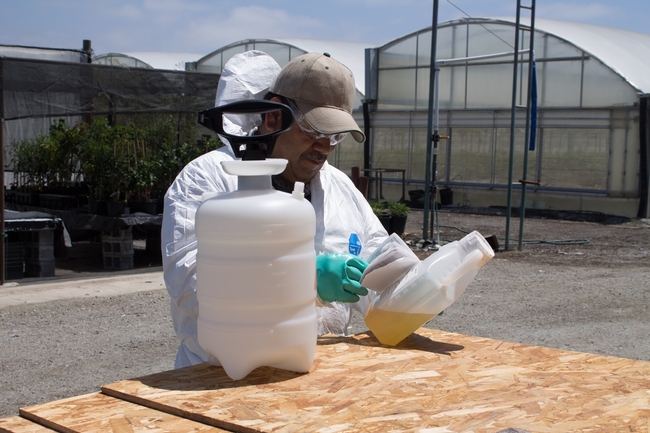
- Author: Ben Faber
Laurel Wilt Disease of Avocado and the relatives of avocado in the Laurel Family has devastated the the forests along the east coast from North Carolina down to Florida and along the Caribbean into Texas. It has caused significant losses to wildlands and to the Florida avocado industry.
The extent of the native tree loss is shocking and there is very little that can be done to correct the problem, other than to curb the spread of contaminated wood that is spread by humans, There has been some success in the avocado orchards. While there is no "silver bullet", there is some progress, e.g. pruning to increase light levels to suppress Ambrosia Beetle activity. In addition, research has continued for:
- Vaccinations to protect avocado trees from the LW pathogen
- Developing a faster LW diagnostic tool
- Screening scions and rootstocks for tolerance/resistance
- AB control tactics and suppression
- Molecular understanding of the pathogen
- Economics and the LW epidemic
Read the latest results in these two recent publications:
Photo: Dead avocado trees from Laurel Wilt in Florida
